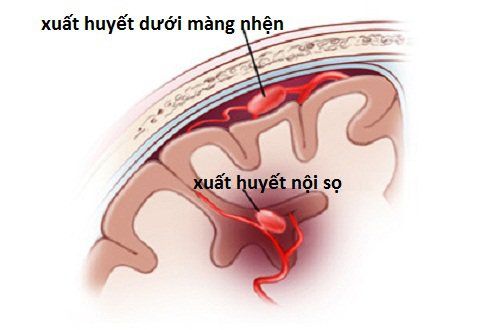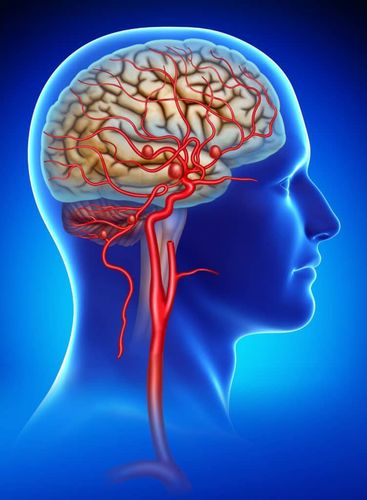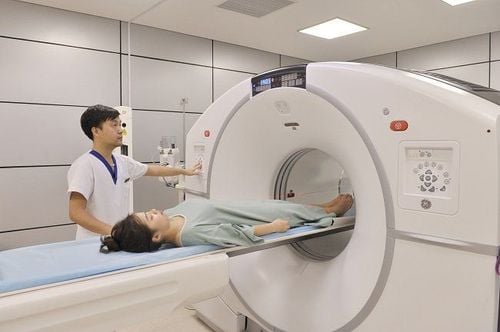This is an automatically translated article.
A brain aneurysm is a bulge of an artery where it has a thin, weak wall. Under high blood pressure in the arteries, they will be at risk of rupture and cause intracranial hemorrhage, leaving the patient in a critical condition or leaving serious sequelae later. Therefore, the indication for microsurgical clamping of cerebral aneurysms should be considered early, in order to prevent events and improve long-term outcomes.
1. What is brain aneurysm clamp surgery?
The goal of cerebral aneurysm clamping surgery is to separate the aneurysm from the normal circulation of cerebral blood flow. The surgery is performed under the condition that the patient is under general anesthesia and the skull is opened. The brain parenchyma will be gently reduced to make it easier to locate the aneurysm. A small metal clip will be placed over the neck of the brain aneurysm to block the normal flow of blood from continuing into the bag. As such, the clips are made of titanium, a metal that is highly inert and will stay on the brain arteries permanently.
In clinical practice, brain aneurysms vary in size and shape. They may have a neck rooted on the main artery and an arch that develops as round as a ball. This is the easiest condition to place the clip. In contrast, there are some cerebral aneurysms with wide necks or tubular aneurysms without an obvious neck that are more difficult to intervene with clipping. As a result, required clips need to be created in a variety of shapes, sizes and lengths; At the same time, indications for surgical intervention also need to be considered before.

Đặt clip ở cổ túi phình động mạch não để chặn dòng máu chảy vào túi
2. Indications for brain aneurysm intervention in each case like?
Cerebral aneurysms can be diagnosed in a very different setting, such as incidentally discovered, symptomatic aneurysm, or complicated aneurysm. However, in clinical practice, aneurysms are approached in two groups: unruptured and ruptured.
2.1. Unruptured Aneurysms The optimal management of acquired unruptured aneurysms remains under investigation. Scientists still don't know what happens if they aren't treated. At the same time, the risks associated with aggressive treatment of an unruptured aneurysm in the first place cannot be completely avoided. Thus, when deciding whether to treat an unruptured aneurysm, the risks of treatment are compared with the risks of no intervention.
Specifically, decisions about treatment must be individualized. Your doctor will consider the following factors:
Large aneurysms are more likely to rupture Cerebral aneurysms located in certain areas of the brain may be more likely to rupture Patients with ruptured aneurysms Previous brain aneurysm may increase the risk of future aneurysm rupture Patients with a family history of aneurysms may be more likely to rupture 2.2. Once an aneurysm ruptures and causes intracranial bleeding there is a high risk of recurrent rupture, especially within 48 to 72 hours of the initial event. With each such cerebral hemorrhage, the patient's chance of recovery decreases, the risk of sequelae increases. For this reason, ruptured aneurysms are ideally treated as soon as possible.
However, for patients who are in a deep coma, have other serious medical conditions, or are advanced in age and have a short prognosis, treatment may worsen their condition more quickly. In these situations, the indication for treatment is often delayed until the patient is more stable to be reconsidered.
3. In which case is microsurgery to clamp the brain aneurysm?
Microsurgery clamping cerebral aneurysm will be an effective indication for cerebral aneurysm treatment in the following situations:
The brain aneurysm has ruptured and caused bleeding into the space between the brain and the skull , called a subarachnoid hemorrhage. The risk of recurrent brain bleeding would be 22% within the first 14 days after the first event. The timing of surgery is therefore crucial - usually within 72 hours of the first bleeding. An unruptured brain aneurysm may cause no symptoms and is often discovered incidentally during a routine physical exam or visit for another medical condition. The risk of rupture of a brain aneurysm is about 1% per year but can be higher or lower depending on the size and location of the aneurysm. However, when rupture occurs, the risk of death is 40% and the risk of sequelae is 80%.

Vỡ túi phình động mạch não dẫn tới nguy cơ tử vong cao
4. How to consider microsurgery to clamp brain aneurysm compared with endovascular intervention?
The decision to perform aneurysm clamp surgery or endovascular intervention will depend on the size of the aneurysm, location and neck shape of the aneurysm.
The advantages are that the limited invasiveness of endovascular intervention is preferable in patients who are elderly, in poor health, have multiple severe comorbidities, or aneurysms in certain locations are difficult to access . However, in the group of patients under 40 years of age, the difference in efficacy and safety between surgery and endovascular intervention was not significant. Meanwhile, with clipping the brain aneurysm with a clip through the craniotomy, it has also been shown to provide better long-term protection from the risk of cerebral hemorrhage, which may bring more benefit to the patient.
Regarding the comparison of long-term results between these two methods, a lot of research is still going on. Aneurysm clipping has proven long-term effectiveness for decades. In contrast, coil endovascular intervention is still a relatively new technique and its true long-term protection is still not fully understood.
Therefore, the best treatment indication remains highly individualized. In addition, the implementation of any intervention method depends on the available conditions, facilities as well as the qualifications, technique and experience of the neurosurgeon.
In summary, surgical clamping of cerebral aneurysms is the classic treatment modality for cerebral aneurysms. Although modern endovascular interventions are less invasive and preferred, clipping the aneurysm still retains certain benefits that cannot be replaced. Therefore, indications for microsurgical clamping of cerebral aneurysms still need to be considered depending on each case, in order to bring the best treatment effect to the patient. References: silverneurosurgery.com, sciencedirect.com, bafound.org













